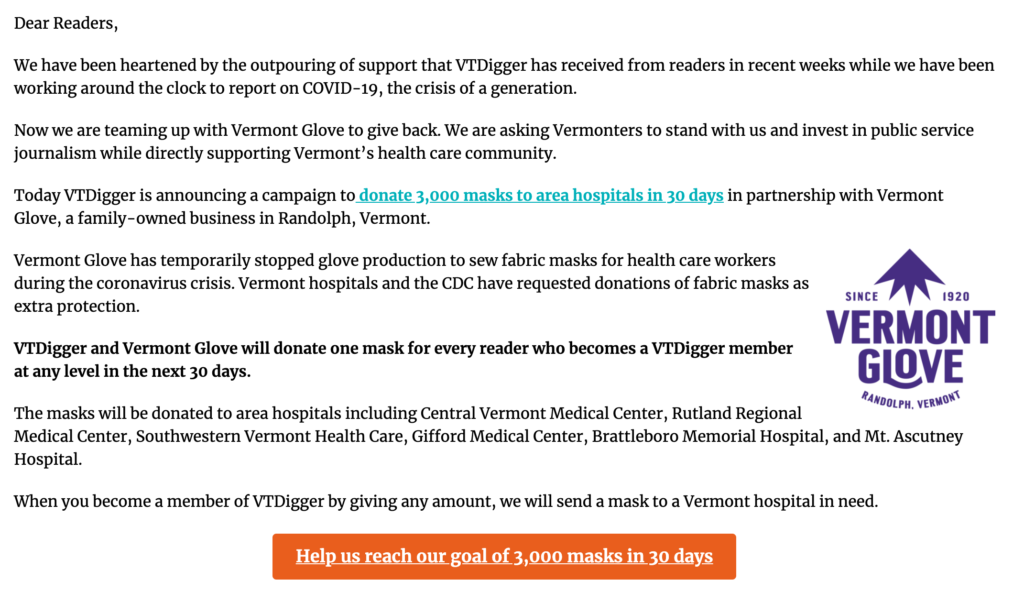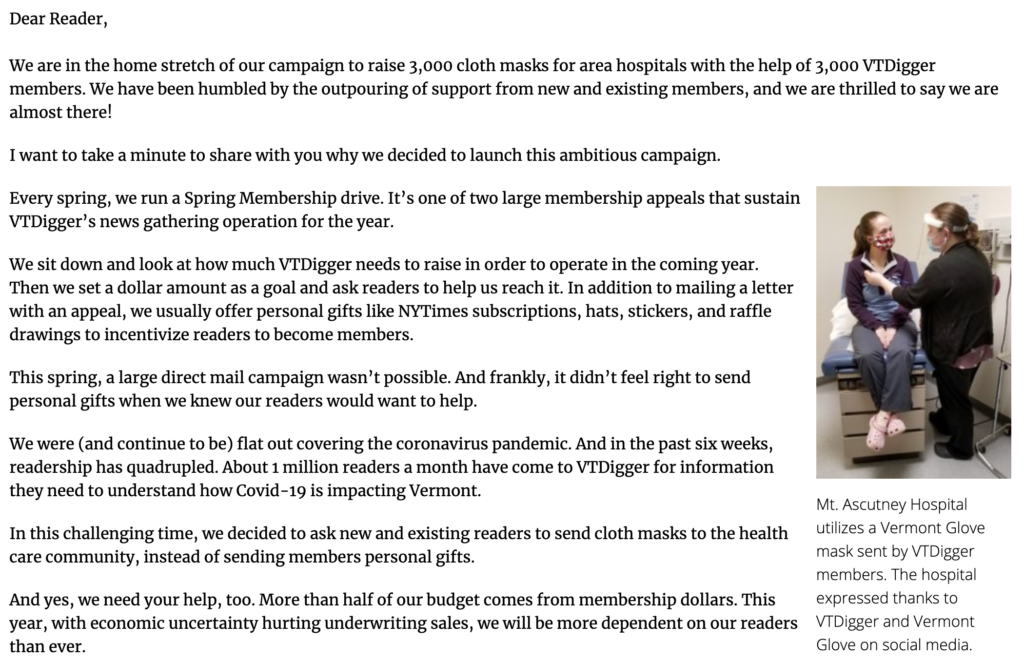Newsroom overview
A nonprofit, statewide newsroom that does watchdog reporting on state government, politics, consumer affairs, business and public policy
Vermont, U.S.
2009
2016
725,000
8,400
22 percent
VTDigger is known for its strong, investigative journalism and its diversified business model. Today, they have a staff of around 25 full-time employees, with Florencio Terra, Membership Coordinator, Libbie Pattison, Campaign Coordinator, and Stacey Peters, full-stack web developer, leading the charge on the newsroom’s membership and audience-input work.
Underpinning that success is their system of systematically asking for audience feedback and input and using it to refine what they offer readers and members. As Peters put it: “We pride ourselves on asking for little chunks of information wherever we can.”
This case study shows how a few straightforward surveys, including an automated one running in the background, can be used to continually add to your understanding of your audience segments and help you take steps to serve them better.
Why this is important
Audience research can be a big, daunting survey – or it can be short requests for audience input during a brief moment when you have their full attention. There isn’t anything unusual about VTDigger’s approach to audience research. But their suite of surveys and their commitment to always following up with respondents give the staff a highly useful picture of their audience needs and reassure the audience that they’re being heard, which makes them more likely to respond again in the future.
MPP offers this case study as an example of how a newsroom can begin conducting audience research in a low-effort, high-impact way.
What they did
VTDigger’s audience research can be divided into three parts:
- Its annual, comprehensive reader survey, which focuses on reader’s attitudes toward VTDigger and it coverage,
- One-off surveys soliciting feedback on specific products, and
- Small, quick opportunities for audiences to give input.
Annual reader survey: VTDigger sends out a reader survey in SurveyMonkey once a year. They began this practice in 2013, a few years after their launch. They distribute the survey by posting it on their site and sharing it via their newsletter list. In order to increase survey participation, they also resend the survey email to anyone who hasn’t opened it after a week. Their goals for the most recent annual survey were to identify the other channels and types of news readers use and pay for, to check their understanding of audience demographic information, and to see how satisfied their current audiences are with their coverage and products. In other words, this survey mainly serves as competitive landscape research to help them identify coverage and distribution gaps they could fill. The survey also includes several explicit questions related to VTDigger’s membership program (see example below). Here’s their 2019 survey.
Survey for product: When VTDigger is refining or about to launch a new product for their readers, they’ll seek audience input on that specific product. Prior to launching their 2020 Election Guide (a roundup for Vemonters about the candidates, how they can vote during COVID, and the latest election news), they wanted to know how to frame reporter’s interviews and write-ups with candidates. They sent out a survey asking readers if what they wanted to hear about from the candidates, and what issues mattered the most to them. Here’s their reader survey for VTDigger’s election guide.
Small, quick inputs: VTDigger credits Rebekah Monson, co-founder and COO of WhereBy.Us for this one: when people unsubscribe from your newsletter list, ask them why. VTDigger added a field to their newsletter unsubscribe confirmation page asking “Please let us know why you unsubscribed” to gather feedback in real-time. Since their newsletter is a primary driver of membership growth and engagement, they see feedback on this product as a vital temperature check on their membership strategy writ large.
The results
Annual reader survey: In total in 2019, VTDigger received 1,747 survey responses from their audience members. Their 2019 survey revealed a big increase in their readers’ interest in local news – in the past, statewide news, especially governance and legislature, was the top interest.
Based on two data points from the annual survey (the high percentage of readers who wanted to see more newsletters, and the topics most of those readers were interested in) VTDigger created new weekly email newsletters based on particular beats: education, environment, criminal justice, health care, and politics. The team then added calls-to-action on stories within those beats, asking the reader to subscribe to the related topical newsletter. Within four months, VTDigger gained between 5,000 and 8,000 subscribers to each of these new email newsletter lists — a clear indicator that they successfully delivered on incorporating feedback from their audiences.
The “unsubscribe” survey: Their single-question unsubscribe question revealed that the most common reason people unsubscribe was “I just get too many emails.” Newsletters are the best way VTDigger gains new members, so they wanted to keep them in some way. They updated the unsubscribe page with an option for users to instead downgrade to weekly summaries. They have not yet measured the success of this, but plan on reviewing in the coming months.
What they learned
From their “unsubscribe” survey, the team collected data that allowed them to prioritize newsletter reader preferences. VTDigger learned they have a lot of seasonal residents and second-home owners, so they often get unsubscribe messages like this one: “I am away from VT for a while and have so many emails!” Eventually, they would like to be able to offer a “restart” date for their newsletter, to allow these folks to freeze their subscription for a certain period of time. But they haven’t reached a point where the potential impact of this change is worth the effort and cost to implement it. They’re okay with losing newsletter subscribers over this type of complaint for now.
For their annual survey, VTDigger learned the importance of offering small incentives to bring in more responses from readers. This past year, they offered all respondents a chance to enter a raffle for a $100 gift card to Bear Pond Books, a local bookstore based in Montpelier, Vermont. This helped the team recruit a large set of survey participants.
VTDigger learned the importance of incorporating new types of survey questions into their annual survey year after year. Instead of keeping the survey format the same, they add new questions depending on their product and membership goals for the upcoming year. For example, this upcoming year they are considering launching a member-only or paid newsletter. They plan on adding a few specific questions to their 2020 Annual Survey that will help them determine if this is a viable product to offer, and if so, how they can cater the product to their members information needs and ideal user experience.
Key takeaways and cautionary notes
Look for high-attention moments when you can collect small bits of feedback. Even though it was a negative circumstance, asking readers why they’re unsubscribing as they unsubscribe works because you have their full attention. Look for similar opportunities when readers are highly focused on your site and you can ask related questions.
Audience research is a cultural mindset. VTDigger has prioritized feedback from the beginning. When it launched, it had a way for readers to submit a tip, report an error, or upload documents at the bottom of every story. Today, the newsroom gets between 50 and 100 tips every month and the VTDigger team reads and follows up on every tip that comes in. Some people complain that they spent too much time at the DMV, while others submit tips that lead to VTDigger breaking news. Getting tips like those requires a cultural commitment to always be listening to readers so that they feel comfortable coming to you when they have something to share.
Audience research needs a clear workflow to be actionable. Over the years, VTDigger has developed clear workflows for creating and acting on audience research findings. For example, every submission via the bottom-of-story tips request gets emailed to their four-member edit desk and logged in a spreadsheet, where editors log their follow ups. The spreadsheet also allows the team an overview so that it can identify patterns across the state.
Other resources
- Shorenstein Center, case study: VTDigger: A Rising Star In Nonprofit News
- VTDigger, resource: 2019 annual survey
- VTDigger, resource: Election survey



